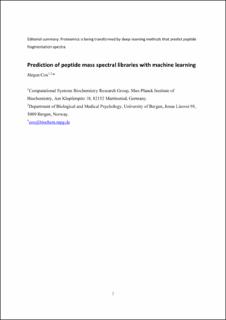Prediction of peptide mass spectral libraries with machine learning
Journal article, Peer reviewed
Accepted version
Permanent lenke
https://hdl.handle.net/11250/3063554Utgivelsesdato
2022Metadata
Vis full innførselSamlinger
Sammendrag
The recent development of machine learning methods to identify peptides in complex mass spectrometric data constitutes a major breakthrough in proteomics. Longstanding methods for peptide identification, such as search engines and experimental spectral libraries, are being superseded by deep learning models that allow the fragmentation spectra of peptides to be predicted from their amino acid sequence. These new approaches, including recurrent neural networks and convolutional neural networks, use predicted in silico spectral libraries rather than experimental libraries to achieve higher sensitivity and/or specificity in the analysis of proteomics data. Machine learning is galvanizing applications that involve large search spaces, such as immunopeptidomics and proteogenomics. Current challenges in the field include the prediction of spectra for peptides with post-translational modifications and for cross-linked pairs of peptides. Permeation of machine-learning-based spectral prediction into search engines and spectrum-centric data-independent acquisition workflows for diverse peptide classes and measurement conditions will continue to push sensitivity and dynamic range in proteomics applications in the coming years.
